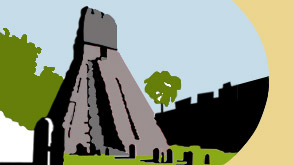 |
|---|
|
|---|
|
|---|
Iconography and epigraphy are two aspects of Maya studies which have provided a majority of the breakthroughs in knowledge of Maya culture over the last two decades. Epigraphy, the study of writing systems, in this case Mayan hieroglyphic writing, has been part of Maya studies since the last century. Iconography did not become a major force until 1973; prior to the appearance of Michael Coe's book in that year, major monographs on iconography were limited to those of Spinden (1913) and Kubler (1969). Robert Smith produced initial work in iconography of ceramics as did Thompson for the codices, leaning heavily on the work of Eduard Seler.
Iconography is also the study of design motifs, which are usually abbreviated abstracted references to more complex entities, states of being, or aspects of the cosmos. Since flowers, fish, reptiles, deer, felines, monkeys, and other creatures were part of the cast of characters in Maya myths, both whole creatures, composites (mixtures such as the feathered-serpent), and abbreviations occur. Small abstracted attributes, decorations, or portions of animals were used as isolated motifs. Iconography involves recognizing which designs come from which natural animal, and what part of that animal. Thus iconography is multi-disciplinary; a keen eye for tropical flora and fauna is called for. A reference library of plants and animals of Belize, Guatemala, Mexico, and Honduras is often as important as the archaeology monographs of the Carnegie Institution of Washington. Iconography is thus the study of meaning in art. In Maya studies, iconography is the analysis of meaning of the designs and symbols, identification of the clothing and accessories, recognition of the name, rank, and meaning of the deities and mythical personages, and discussion of the situation. Situation is usually the cosmological framework or state of being. The state of being may be life after death, trance, or under the influence of various potent native stimulants. Maya art and archaeology has been the subject matter of thirty years of photography of pre-Columbian antiquities throughout Mesoamerica to form the F.L.A.A.R. Photo Archive. This research resource includes over 40,000 slides and negatives of Maya art, architecture, and related tropical flora and fauna of prehispanic Belize, Guatemala, Mexico, and Honduras. Of this total an estimated 8,000 photographs cover Maya architecture; over 2,000 slides cover the art of other Mesoamerican civilizations such as Olmec, Mixtec, Zapotec, Toltec, and Teotihuacan. In the United States the study of Maya art takes place either within a Department of Anthropology, Department of Archaeology, Institute of Art History, or a museum. In Europe studies of Alt-Amerika are often together with the studies of indigenous languages such as Nahuatl (spoken by the Aztec) or the various Mayan languages spoken in Central America. Research on Maya art may include the analysis of style, of materials (the artifacts), or of technique (how the colors were made, how the materials were prepared or worked). The F.L.A.A.R. Photo Archive is entering its fourth decade devoted to finding and photographing Maya art whereever it may be in the world. The Photo Archive is currently preparing an inventory of all Maya ceramic art in the museums and private collections of Japan. F.L.A.A.R. has photographed Maya art in most of the major countries and leading museums around the world. Currently F.L.A.A.R. is working on establishing which hardware and software is optimum for transferring these negatives and transparencies into digital format. F.L.A.A.R. has received several substantial grants for this research and we report on our digital imaging research results in a variety of Web sites. The key results are available directly from the following links.
desktop publishing (how best to print your reports, class notes, publish in your own office) edited July 18, 1999; new links added March 6, 2000 |
|---|